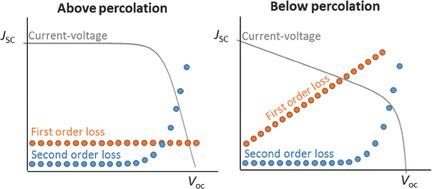当前位置:
X-MOL 学术
›
Adv. Energy Mater.
›
论文详情
Our official English website, www.x-mol.net, welcomes your
feedback! (Note: you will need to create a separate account there.)
Recombination Losses Above and Below the Transport Percolation Threshold in Bulk Heterojunction Organic Solar Cells
Advanced Energy Materials ( IF 24.4 ) Pub Date : 2018-03-13 , DOI: 10.1002/aenm.201703339 Aren Yazmaciyan 1 , Martin Stolterfoht 2 , Paul L. Burn 3 , Qianqian Lin 4 , Paul Meredith 3, 5 , Ardalan Armin 5, 6
Advanced Energy Materials ( IF 24.4 ) Pub Date : 2018-03-13 , DOI: 10.1002/aenm.201703339 Aren Yazmaciyan 1 , Martin Stolterfoht 2 , Paul L. Burn 3 , Qianqian Lin 4 , Paul Meredith 3, 5 , Ardalan Armin 5, 6
Affiliation

|
Achieving the highest power conversion efficiencies in bulk heterojunction organic solar cells requires a morphology that delivers electron and hole percolation pathways for optimized transport, plus sufficient donor:acceptor contact area for near unity charge transfer state formation. This is a significant structural challenge, particularly in semiconducting polymer:fullerene systems. This balancing act in the model high efficiency PTB7:PC70BM blend is studied by tuning the donor:acceptor ratio, with a view to understanding the recombination loss mechanisms above and below the fullerene transport percolation threshold. The internal quantum efficiency is found to be strongly correlated to the slower carrier mobility in agreement with other recent studies. Furthermore, second‐order recombination losses dominate the shape of the current density–voltage curve in efficient blend combinations, where the fullerene phase is percolated. However, below the charge transport percolation threshold, there is an electric‐field dependence of first‐order losses, which includes electric‐field‐dependent photogeneration. In the intermediate regime, the fill factor appears to be limited by both first‐ and second‐order losses. These findings provide additional basic understanding of the interplay between the bulk heterojunction morphology and the order of recombination in organic solar cells. They also shed light on the limitations of widely used transport models below the percolation threshold.
中文翻译:

在大容量异质结有机太阳能电池中,输运渗流阈值以上和以下的重组损失
要在整体异质结有机太阳能电池中实现最高的功率转换效率,就需要一种能提供电子和空穴渗流路径以优化传输的形态,以及足够的供体:受体接触面积,以形成接近统一的电荷转移态。这是一个重大的结构挑战,特别是在半导体聚合物:富勒烯体系中。通过调整供体:受体比例研究了高效PTB7:PC70BM共混物模型中的这种平衡作用,以了解富勒烯转运渗透阈值以上和以下的重组损失机理。发现内部量子效率与较慢的载流子迁移率密切相关,这与其他最近的研究一致。此外,在富勒烯相被渗透的有效共混混合物中,二阶复合损耗决定了电流密度-电压曲线的形状。但是,在电荷传输渗漏阈值以下,存在一阶损耗的电场依赖性,其中包括电场依赖性的光生。在中间状态下,填充因子似乎受到一阶和二阶损失的限制。这些发现为有机太阳能电池中本体异质结形态与重组顺序之间的相互作用提供了额外的基本理解。他们还揭示了渗透阈值以下广泛使用的运输模型的局限性。低于电荷输运渗透阈值,则存在一阶损耗的电场依赖性,其中包括电场依赖性的光生。在中间状态下,填充因子似乎受到一阶和二阶损失的限制。这些发现为有机太阳能电池中本体异质结形态与重组顺序之间的相互作用提供了额外的基本理解。他们还揭示了渗透阈值以下广泛使用的运输模型的局限性。低于电荷输运渗透阈值,则存在一阶损耗的电场依赖性,其中包括电场依赖性的光生。在中间状态下,填充因子似乎受到一阶和二阶损失的限制。这些发现为有机太阳能电池中本体异质结形态与重组顺序之间的相互作用提供了额外的基本理解。他们还揭示了渗透阈值以下广泛使用的运输模型的局限性。这些发现为有机太阳能电池中本体异质结形态与重组顺序之间的相互作用提供了额外的基本理解。他们还揭示了渗透阈值以下广泛使用的运输模型的局限性。这些发现为有机太阳能电池中本体异质结形态与重组顺序之间的相互作用提供了额外的基本理解。他们还揭示了渗透阈值以下广泛使用的运输模型的局限性。
更新日期:2018-03-13
中文翻译:

在大容量异质结有机太阳能电池中,输运渗流阈值以上和以下的重组损失
要在整体异质结有机太阳能电池中实现最高的功率转换效率,就需要一种能提供电子和空穴渗流路径以优化传输的形态,以及足够的供体:受体接触面积,以形成接近统一的电荷转移态。这是一个重大的结构挑战,特别是在半导体聚合物:富勒烯体系中。通过调整供体:受体比例研究了高效PTB7:PC70BM共混物模型中的这种平衡作用,以了解富勒烯转运渗透阈值以上和以下的重组损失机理。发现内部量子效率与较慢的载流子迁移率密切相关,这与其他最近的研究一致。此外,在富勒烯相被渗透的有效共混混合物中,二阶复合损耗决定了电流密度-电压曲线的形状。但是,在电荷传输渗漏阈值以下,存在一阶损耗的电场依赖性,其中包括电场依赖性的光生。在中间状态下,填充因子似乎受到一阶和二阶损失的限制。这些发现为有机太阳能电池中本体异质结形态与重组顺序之间的相互作用提供了额外的基本理解。他们还揭示了渗透阈值以下广泛使用的运输模型的局限性。低于电荷输运渗透阈值,则存在一阶损耗的电场依赖性,其中包括电场依赖性的光生。在中间状态下,填充因子似乎受到一阶和二阶损失的限制。这些发现为有机太阳能电池中本体异质结形态与重组顺序之间的相互作用提供了额外的基本理解。他们还揭示了渗透阈值以下广泛使用的运输模型的局限性。低于电荷输运渗透阈值,则存在一阶损耗的电场依赖性,其中包括电场依赖性的光生。在中间状态下,填充因子似乎受到一阶和二阶损失的限制。这些发现为有机太阳能电池中本体异质结形态与重组顺序之间的相互作用提供了额外的基本理解。他们还揭示了渗透阈值以下广泛使用的运输模型的局限性。这些发现为有机太阳能电池中本体异质结形态与重组顺序之间的相互作用提供了额外的基本理解。他们还揭示了渗透阈值以下广泛使用的运输模型的局限性。这些发现为有机太阳能电池中本体异质结形态与重组顺序之间的相互作用提供了额外的基本理解。他们还揭示了渗透阈值以下广泛使用的运输模型的局限性。











































 京公网安备 11010802027423号
京公网安备 11010802027423号